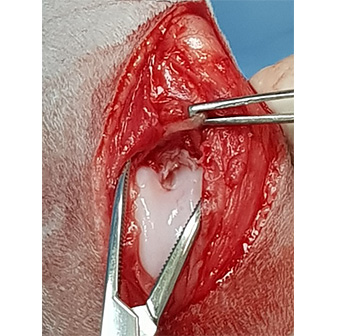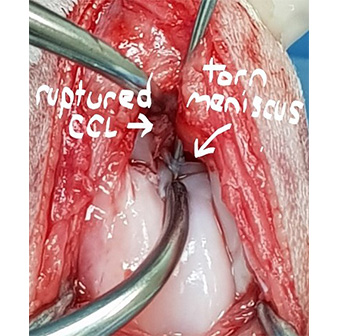Open 7 days
- Mon - Fri 8am-8pm
- Sat 8am-12pm
- Sun 8am-12pm
After hours veterinary care
After hours veterinary care
Maybe your dog has gone suddenly lame or perhaps there has been a mild lameness for a while that seems to go away but this time it is worse? You have been to your veterinarian. They think your dog has cruciate disease. A good vet will have suggested radiographs (x-rays) and told you your dog needs cruciate surgery. You had not expected this and you are doing your homework before you decide to get it looked into. You quite rightly want to know, what if I don’t get surgery on my dog’s stifle for canine cruciate disease?
Canine cruciate disease is the most common orthopaedic problem in the dog. The canine stifle is a bit of a disaster anatomically from an engineering point of view. many breeds just have knees (or rather stifles in the dog) that are designed to fail. The tibial plateau angle in many dogs is very steep which puts enormous strain on the cranial cruciate ligament when the leg is fully loaded with weight and add in the forces exerted during athletic activity, the CCL often becomes damaged. Sometimes this is acute but more frequently it tears a little bit at a time and becomes swolen and oedematous from inflammation and degeneration as repeated smaller tears occur. It is common for this ligament to slowly break down like a piece of rope starting to fray.

The image above shows a cranial cruciate ligament that has a grade 3 tear or a complete rupture. You can see the white ends in the centre of the joint that look like frayed rope. These used to be joined together. This dog has a complete rupture of the CCL.
A good veterinarian will be able to diagnose cruciate disease in your dog long before it completely ruptures. A swelling will appear on the inside of the stifle joint from inflammation and fibrosis. This is called a medial buttress. A good veterinarian will be proactive and recommend radiographs to assess the extent of damage to the stifle and to rule out other possible causes of stifle pain such as bone cancer such as osteosarcoma. There are other causes for stifle pain but cruciate disease is the most common. A proactive approach should be taken as there are dire consequences of inaction or conservative treatment, you can check also collie veterinary clinic.
The biggest problem is that without doubt, the ligament will rupture. If the CCL has already completely ruptured your dog must have surgery immediately. If you do not have sugery for your dog with cranial cruciate ligament rupture, there is a very high risk of meniscal injury. If your dog was a bit lame but is now non weight bearing lame on the leg, there is a very high likelihood the meniscus has been damaged.
A meniscal tear is a disaster for the stifle (knee). The meniscus is like a stabilising wedge in the knee. If it is torn, it is excruciatingly painful. An analogy would be the feeling you have when you have a hard, sharp rock stuck in your shoe. It’s actually worse. I have torn a meniscus in my knee and it actually feels like someone is sticking a knife in your knee. It really hurts.
Without a cranial cruciate ligament holding the femur to the tibia in the centre of the knee, the stifle becomes very unstable. The femur is curved at the bottom so it slides caudally when the stifle is loaded with tibial thrust during walking or running. basically the knee is unstable and slides back and forwards creating a shearing action between the bones.
These shearing forces tend to split the medical meniscus in the canine stifle (your dog’s knee). This is called a bucket handle tear and is the most common tear. It can actually split more than once. We now have a very painful joint that your dog cannot walk on. We now have a joint that is going to get very serious osteoarthritis.
This can be prevented with proactive surgery prior to having a complete rupture of the cranial cruciate ligament.

The image above shows a torn cranial cruciate ligament that has a complete rupture. As a result of instability between the femur and tibia the meniscus is torn. This dog had to have a partial meniscectomy to remove the damaged part of the meniscus. This can be prevented with surgery before the cruciate ligament is completely torn.
Once the cranial cruciate ligament is damaged in the dog, a catastrophic course of events have been set in place. It is best to have surgery before there is major ligament damage and severe instability that is called a cranial drawer ie movement between the femur and tibia. If the stifle is not stabilised, meniscal injury is likely and severe pain will result. Chronic inflammation and meniscal injury will lead to severe osteoarthritis.
If you hate the idea of your dog having surgery, we can still help you. It is possible to have a custom made orthosis or orthotic brace for your dog to wear to stabilise the knee (stifle). This is not the best option, however, if you just don’t want your dog to have surgery, you should get one of these. Check out Bunbury vet clinic for more info.
If you found this article interesting, you may also want to read Spinal Injury in Dogs.
Social distancing is easy for pets and people in our spacious waiting areas.



